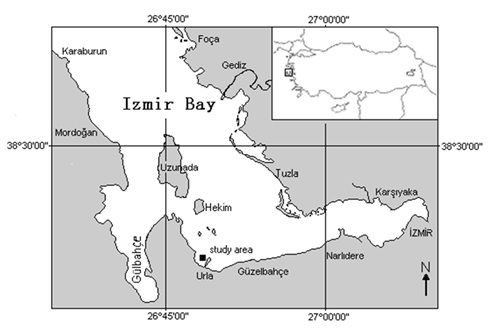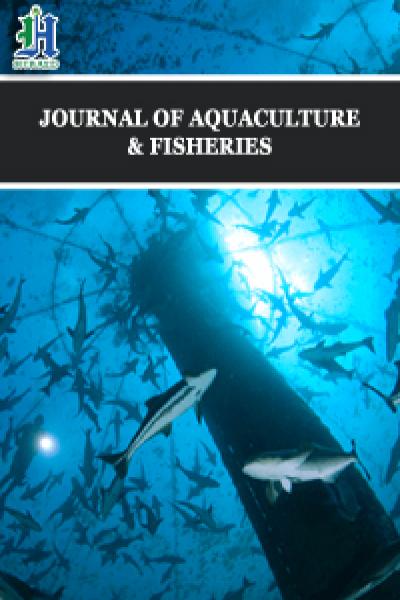
Determination of the Seasonal Yields of Total Fucose and Fucoidan Yields in Brown Seaweeds (Order Fucales) Distributed along the Coast of Urla (izmir, Turkey)
*Corresponding Author(s):
Gamze TuranDepartment Of Aquaculture, Ege University, Bornova, Izmir, Turkey
Tel:+90 2323115217,
Email:gamze.turan@ege.edu.tr
Abstract
The brown seaweeds have been recognized as a potential source of biologically active Fucoidan, a mucilaginous sulfated polysaccharide consisting mainly of a polymer of α-L-fucose-4-sulfate but with persistent amounts of other sugars, mainly Xylose and Galactose and have been reported to have Anti-Cancer, Anti-Obesity and Anti-Inflammatory effects.
This study was carried out to determine the seasonal yields of total Fucose and Fucoidan from brown seaweed species (Order Fucales) of Cystoseira barbata, C. compressa and Sargassum vulgare distributed naturally along the coast of Urla (Izmir, Turkey) using a colorimetric method.
Mean fucoidan yields were 6.44±1.44% (dry weight basis) for Cystoseira barbata, 3.84±1.14% for Sargassum vulgare and 3.04±1.77% for C. compressa (n=3). The highest Fucoidan yields in these species were determined in the fall season (P≤0.05).
Keywords
INTRODUCTION
Brown Seaweed-derived polysaccharides such as Fucoidan, Laminaran, Alginates and Mannitol have been studied due to their biological effectiveness as Anticoagulant, Antitumor, Antithrombotic, Anti-inflammatory, Contraceptive and Antiviral agent [7-10].
Fucoidans, is a term that covers a family of Fucose-Containing Sulfated Polysaccharides (FCSPs), may constitute up to 25-30% of the seaweed dry weight, depending on the seaweed species and, to a lesser extent, on life history stage and season [11,12].
Fucoidans participate in the building of cell walls and the support of their structure, as well as in releasing of spores and gametes from reproductive organs. Due to the sulfated groups, these polysaccharides can bind positively charged ions, such as K+, Na+, Ca2+, Mg2+ and participate in ion exchange with the environment, which facilitates adaptation of seaweeds to water salinity fluctuations and to the toxic effects of heavy metals. Fucoidans play a substantial role in morphogenesis of zygotes of Fucoid algae, as they participate in establishing the cell polarity and fixing the cell-division axis, thus determining the direction for the development of the rhizoidal and apical poles of young thalli [13].
Documented biological functionalities of these compounds are the activities against Hepatitis, Herpes and Human Acquired Immune Deficiency (AIDS) Viruses, the Anticoagulant, Anti-inflammatory Heparin and molecules that modify cell proliferation and adhesion and fertilization functions [13-20].
Despite all the above-mentioned benefits, research on the Fucoidan content of Seaweeds in Turkey is limited.
The aim of the current study was to determine the sulfated polysaccharides (Fucoidan) yields of seaweeds of Cystoseira barbata, C. compressa and Sargassum vulgare (Order Fucales) that are distributed on the Turkish coast. An experimental design was implemented to evaluate the Fucoidan content and effect of the seasonal variation on the Fucoidan yield among the species with specific goal to determine the best time of the year to obtain Fucoidan from natural populations of these species.
MATERIALS AND METHODS
 Figure 1: The map of study area.
Figure 1: The map of study area.EXTRACTION
Colorimetric determination of fucose
The absorbance at 396 and 427 nm was read in this solution. The total Fucose, F, in milligrams was calculated from the following formula:
F= B × 0.06 × V
Where,
B is the difference between the two absorbancy readings (396 and 427 nm)
0.06 is a factor converting absorbance to amount of Fucose in miligrams per mililiter and
V is the total volume of the extract in mililiters
To obtain the approximate amount of Fucoidan of the sample, the Fucose content was multiplied by a factor of 2 [21].
Statistical analysis
RESULTS AND DISCUSSION
| Seaweed Species | Mean*±SD | Minimum | Maximum |
| Cystoseira barbata | 6.44a±1.44 | 4.14 | 8.56 |
| Cystoseira compressa | 3.04b±1.77 | 2.08 | 4.51 |
| Sargassum vulgare | 3.84ab±1.14 | 2.26 | 6.13 |
The fucoidan yields of seaweed species recorded here are similar to that the values in Chotigeat et al. [23], Larsen [21] and Usov et al. [24]. Chotigeat et al. [23] reported a fucoidan content of 2.74±1.18% in dw in Sargassum polycystum, which compared favorably with Pelvetica canaliculata. Larsen (1978) reported a Fucoidan content of 6-8% in dw in Ascophyllum nodusum, 9-11% in Fucus species, 5-20% in Laminaria sp., and 20% in dw in Pelvetia canaliculate. Usov et al. (2001) reported the fucoidan content of between 0.4 and 20.4% in dw in 25 different brown seaweed species and 7.7% in Fucus evanescens (Order Fucales).
Mean Fucoidan yield in Cystoseira barbata was highest in spring and fall and lowest in winter (Table 2). Similarly, mean fucoidan yield in C. compressa was highest in spring and fall and lowest in winter (Table 2). In Sargassum vulgare, Mean Fucoidan yield was highest in fall and summer and lowest in winter (Table 2).
| Species | Seasons* | Mean*±SD |
| C. barbata | Winterb* | 4.79b±1.59 |
| Springa | 6.73a±1.53 | |
| Summerab | 6.22ab±1.61 | |
| Falla | 8.10a±1.60 | |
| C. compressa | Winterb | 2.11b±1.02 |
| Springa | 3.58a±1.85 | |
| Summerab | 2.94ab±1.37 | |
| Falla | 3.55a±1.49 | |
| S. vulgare | Winterb | 2.78b±1.21 |
| Springab | 3.59ab±1.19 | |
| Summerab | 3.96ab±1.10 | |
| Falla | 5.32a±1.24 |
Chotigeat et al. [23] have also reported a seasonal variation in Fucoidan content in the seaweeds they examined, with the highest yields of Fucoidan found in fall.
Addition to species and the season, the extraction method also is an important factor that has great effect on the Fucoidan yields of the sea weeds showed by Wang and Cheng [25]. In the study of Wang and Cheng it was found that the fucoidan content extracted using method I was 13.13% (of dry weight), 24.00% and 22.67% from Sargassum glaucescens, Sargassum horneri and Laminaria japonica, respectively. By contrast, the fucoidan content extracted using method II was 4.20%, 4.80% and 4.64% from S. glaucescens, S. horneri and L. japonica, respectively. The sample sex-tracted using method II were lower in total sugar content but higher in sulfated content than those extracted using method I. Using method II yielded the highest fucose content in S. Glaucescens (20.89%) and Hizikia fusiformis (15.89%).
CONCLUSION
Addition to the species and seasonal conditions, the extraction method has also a significant effect on the yields of Fucoidan. Considering of sulfate content of Fucoidans, it is supposed that the functional activity of fucoidans between the three species will be similar because sulfate is well-known factor of Fucoidan’s biological function. So, each species should be considered a good source for Fucoidan that has the activities against Hepatitis, Herpes and Human Immunodeficiency (AIDS) Viruses, Anticoagulant heparin inflammation, Cell proliferation and adhesion.
ACKNOWLEDGEMENT
REFERENCES
- McHugh DJ (2003) A guide to the seaweed industry. FAO Fisheries technical paper 441: 1-118.
- Ross AB, Jones JM, Kubacki ML, Bridgeman T (2008) Classification of macroalgae as fuel and its thermochemical behavior. Bioresource Technology 99: 6494-6504.
- Anastasakis K, Ross AB, Jones JM (2011) Pyrolysis behavior of the main carbohydrates of brown macro-algae. Fuel 90: 598-607.
- Percival E, McDowell RH (1967) Variations in the carbohydrate content of algae. In: Chemistry and Enzymology of Marine Algal Polysaccharides, (4th edn). London, England.
- O'Sullivan L, Murphy B, McLoughlin P, Duggan P, Lawlor PG, et al. (2010) Prebiotics from marine macroalgae for human and animal health applications. Mar Drugs 8: 2038-2064.
- Lordan S, Ross RP, Stanton C (2011) Marine bioactives as functional food ingredients: potential to reduce the incidence of chronic diseases. Mar Drugs 9: 1056-1100.
- Bhakuni DS, Rawat DS (2005) Bioactive metabolites of marine algae, fungi and bacteria. In: Bhakuni DS, Rawat DS (eds.). Bioactive marine natural products. Springer, New York, USA. pg no: 1-25.
- Imbs TI, Krasovskaya NP, Ermakova SP, Makarieva TN, Shevchenko NM, et al. (2009) Comparative study of chemical composition and antitumor activity of aqueous-ethanol extracts of brown algae Laminaria cichorioides, Costaria costata and Fucus evanescens. Russian Journal of Marine Biology 35: 164-170.
- Wang J, Liu L, Zhang Q, Zhang Z, Qi H, et al. (2009) Synthesized oversulphated, acetylated and benzoylated derivatives of fucoidan extracted from Laminaria japonica and their potential antioxidant activity in vitro. Food Chemistry 114: 1285-1290.
- Mestechkina NM, Shcherbukhin VD (2010) Sulfated polysaccharides and their anticoagulant activity: A review. Applied Biochemistry and Microbiology 46: 267-273.
- Ale MT, Meyer AS (2013) Fucoidans from brown seaweeds: an update on structures, extraction techniques and use of enzymes as tools for structural elucidation. RSC Advances 3: 8131-8141.
- Kusaykin M, Bakunina I, Sova V, Ermakova S, Kuznetsova T, et al. (2008) Structure, biological activity and enzymatic transformation of fucoidans from the brown seaweeds. Biotechnol J 3: 904-915.
- Skriptsova, AV (2015) Fucoidans of brown algae: biosynthesis, localization and physiological role in thallus. Russion Journal of Marine Biology 41: 145-156.
- Ellouali M, Boissonvidal C, Durand P, Josefonvicz J (1993) Antitumor activity of low molecular weight fucans extracted from brown seaweed Ascophyllumnodosum. Anticancer Res 13: 2011-2019.
- Berteau O, Mulloy B (2003) Sulfated fucans, fresh perspectives: structures, functions and biological properties of sulfated fucans and an overview of enzymes active toward this class of polysaccharide. Glycobiology 13: 29-40.
- Ponce NM, Pujol CA, Damonte EB, Flores ML, Stortz CA (2003) Fucoidans from the brown seaweed Adenocystis utricularis: extraction methods, antiviral activity and structural studies. Carbohydr Res 338: 153-165.
- Queiroz KC, Medeiros VP, Queiroz LS, Abreu LR, Rocha HA, et al. (2008) Inhibition of reverse transcriptase activity of HIV by polysaccharides of brown algae. Biomed Pharmacother 62: 303-307.
- Foley SA, Szegezdi E, Mulloy B, Samali A, Tuohy MG (2011) An unfractionated fucoidan from Ascophyllum nodosum: extraction, characterization and apoptotic effects in vitro. J Nat Prod 74: 1851-1861.
- Qu G, Liu X, Wang D, Yuan Y, Han L (2014) Isolation and characterization of fucoidans from five brown algae and evaluation of their antioxidant activity. Journal of Ocean University of China 5: 851-856.
- Zayed A, Muffler K, Hahn T, Rupp S, Finkelmeier D, et al. (2016) Physicochemical and biological characterization of fucoidan from fucus vesiculosus purified by dye affinity chromatography. Mar Drugs 14.
- Larsen B (1978) Fucoidan. In: Hellebust JA, Craigie JS (eds.). Handbook of Phycological Methods. University Press, Cambridge, Canada. Pg no: 151-156.
- Ozdamar K (1997) Package Programmeand Statistical Data Analysis 1. Anatolia University Publishing, Publication number 1001, Faculty of Science Publication number 11, Eskisehir (In Turkish).
- Chotigeat W, Tongsupa S, Supamataya K, Phongdara A (2004) Effect of fucoidan on disease resistance of black tiger shrimp. Aquaculture 233: 23 -30.
- Usov AI, Smirnova, GP, Klochkova, NG (2001) Polysaccharides of Algae: 551. Polysaccharide composition of several brown algae from kamchatka. Russian Journal of Bioorganic Chemistry 27: 395-399.
- Wang CY, Chen YC (2016) Extraction and characterization of fucoidan from six brown macroalgae. Journal of Marine Science and Technology 24: 319-328.
Citation: Turan G, Cirik S, Tekogul H, Koru E, Karacalar U, et al. (2017) Determination of the Seasonal Yields of Total Fucose and Fucoidan Yields in Brown Seaweeds (Order Fucales) Distributed along the Coast of Urla (izmir, Turkey). J Aquac Fisheries 1: 005.
Copyright: © 2017 Gamze Turan, et al. This is an open-access article distributed under the terms of the Creative Commons Attribution License, which permits unrestricted use, distribution, and reproduction in any medium, provided the original author and source are credited.

